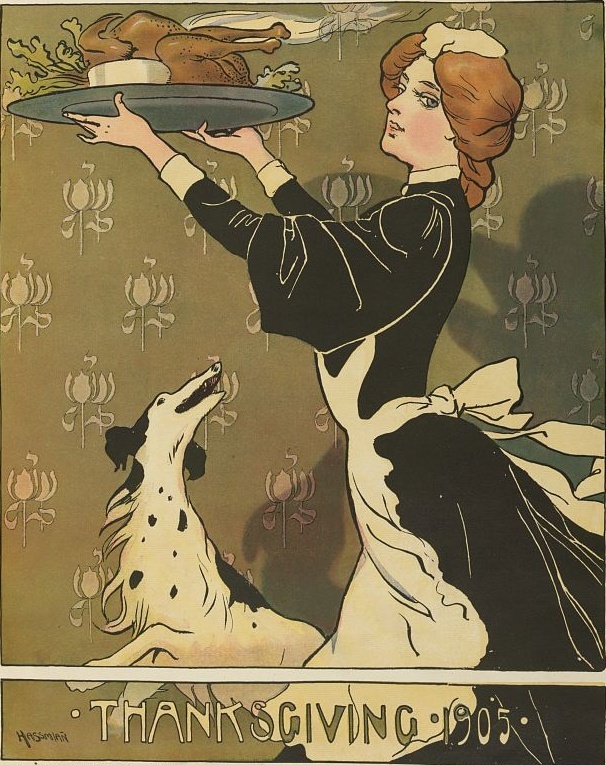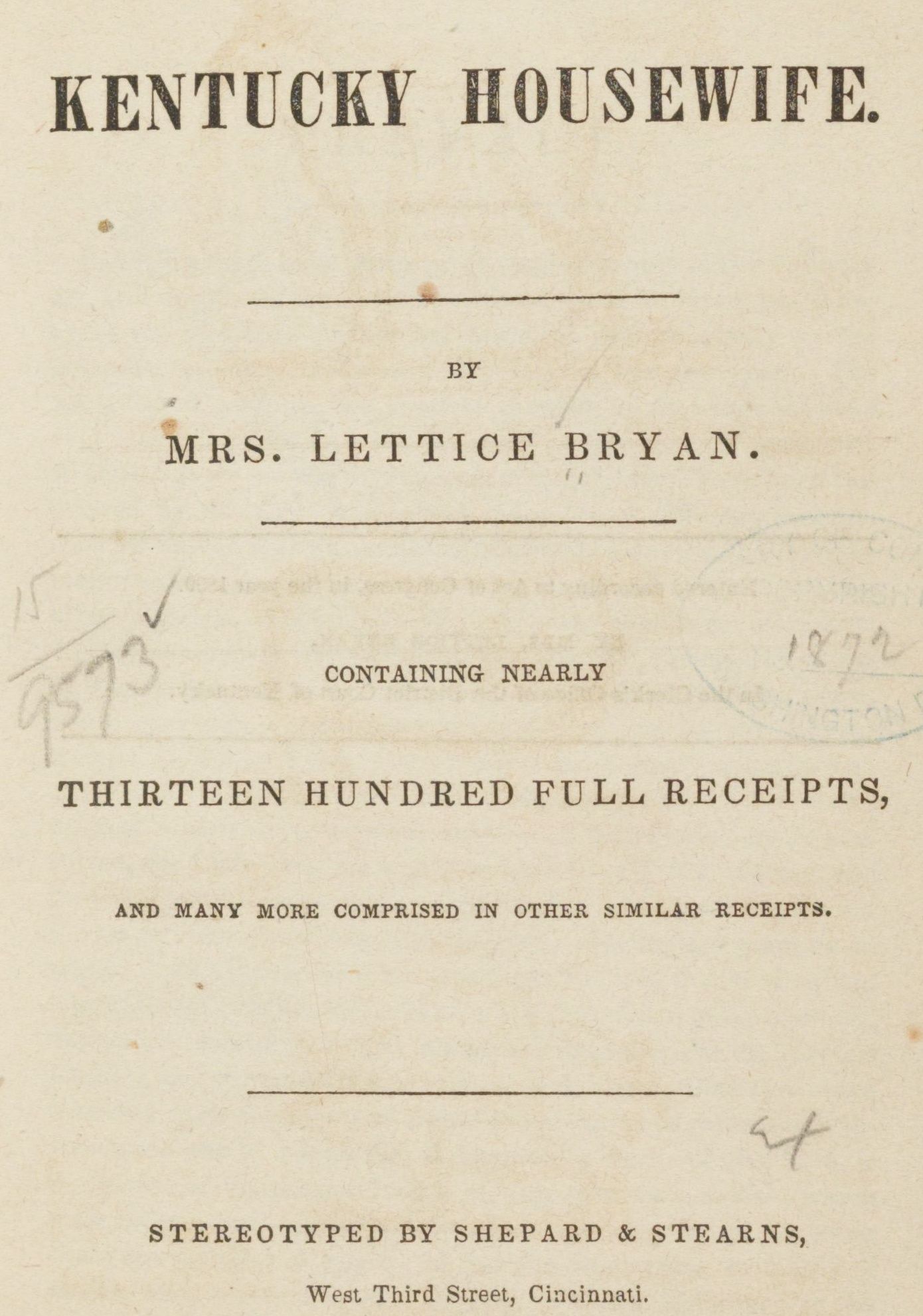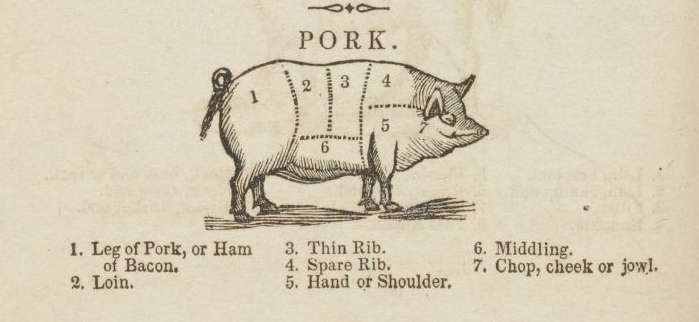Looking for a culinary challenge this Thanksgiving? Consider preparing your Thanksgiving dinner like it was 1796. The following recipes are from American Cookery by Amelia Simmons, the first cookbook written by an American, for an American audience, and published in the United States. Before its publication in 1796, only British cookbooks or American reprints of British cookbooks were available. The unique grammar and spelling are from the original publication.
To Stuff a Turkey
Grate a wheat loaf, one quarter of a pound of butter, one quarter of a pound salt pork, finely chopped, 2 eggs, a little sweet marjoram, summer savory, parsley and sage, pepper and salt (if the pork be not sufficient), fill the bird and sew up. Some add a gill of wine.
The same will answer for wild fowl.
Water fowls require onions.
The same ingredients stuff a leg of veal, fresh pork or a loin of veal.
Hang down to a steady solid fire, basting frequently with salt and water, and roast until steam emits from the breast. Put one third of a pound of butter into the gravy, dust flour over the bird and baste with gravy. Serve up with boiled onions and cranberry-sauce, pickles or celery.
Vegetables
Mrs. Simmons expected her readers grew and preserved vegetables the previous summer. If you had followed her recommendations for gardening and preserving peas, these would be excellent Thanksgiving recipes for side dishes.
To boil Cabbage.
If your cabbage is large, cut it into quarters; if small, cut it in halves; let your water boil, then put in a little salt, and next your cabbage with a little more salt upon it; make your water boil as soon as possible, and when the stalk is tender, take up your cabbage into a cullender, or sieve, that the water may drain off, and send it to table as hot as you can. Savoys are dressed in the same manner.
To keep Green Peas till Christmas.
Take young peas, shell them, put them in a cullender to drain, then by a cloth four or five times double on a table, then spread them on, dry them very well, and have your bottles ready, fill them, cover them with mutton suet fat when it is a little soft; fill the necks almost to the top, cork them, tie a bladder and a leather over them and set them in a dry cool place.
Dessert
Mrs. Simmons provided numerous recipes for delicious desserts. However, to prepare these historical recipes for Thanksgiving, you’ll need to build a fire in the hearth instead of using your oven. Prior to the invention of the cast iron wood or coal heated stoves in the early 1800s, food was prepared on an open hearth. “Baked” desserts were boiled, steamed or baked in pots over the fire or hot coals.
A Nice Indian Pudding
3 pints of scalded milk, 7 spoons fine Indian meal, stir well together while hot, let stand till cooled. Add 7 eggs, half pound of raisins, 4 ounces butter, spice and sugar. Put into a strong cloth, brass or metal vessel, stone or earthen pot, secure from wet and boil 12 hours.
Pompkin Pudding
No. 1. One quart stewed and strained, 3 pints cream, 9 beaten eggs, sugar, mace, nutmeg and ginger, laid into paste No. 7 or 3, and with a dough spur, cross and chequer it, and baked in dishes three quarters of an hour.
No. 2. One quart of milk, 1 pint pompkin, 4 eggs, molasses, allspice and ginger in a crust, bake 1 hour.
A Plain Cake
Two quarts of milk, 3 pound of sugar, 3 pound of shortening, warmed hot. Add a quart of sweet cider, let this curdle, add 18 eggs, allspice and orange to your taste, or fennel, caraway or coriander. Put in 9 pounds of flour and 3 pints of emptins (liquid yeast). Bake well.
Syllabub – To make a fine syllabub from the cow
Sweet a quart of cider with sugar, grate nutmeg into it, then milk your cow into your liquor. When you have thus added what quantity of milk you think proper, pour half a pint or more, in proportion to the quantity of syllabub you make, of the sweetest cream you can get all over it. Whip it with a whisk, take off the froth as it rises and put it into your syllabub glasses or pots, and they are fit for use.
Full text of American Cookery, 1798 edition. Mrs. Simmons’ cookbook was so popular it was reprinted for over 30 years after its original publication in 1796.
To learn more about cooking in the pre-industrial era and historical recipes and food facts:
 How has technology changed how we cook over time? (classroom activities included)
How has technology changed how we cook over time? (classroom activities included)- Food through Time: Exploring Social History with Etymology (classroom activities included)
- Mrs. Bryan’s “Kentucky Housewife”: Managing a Household in the 1830s
- What’s a shoat?
- Saleratus, Pudding and a Gill: How Old Words Reflect a Changing World
- Investigating Family, Food, and Housing Themes in Social Studies

About the header image: Cover of Puck Magazine,1905. Courtesy of Library of Congress.

 How has technology changed how we cook over time?
How has technology changed how we cook over time?


I could use this post to teach first-grade students about the history of food traditions for holidays. This post shows students how we still eat some of the dishes from the late 1700s.
I could use this to teach a lesson about Thanksgiving. This content would be perfect in any elementary level setting. I could cook some of these foods so that the children could see traditional foods from the late 18th century.